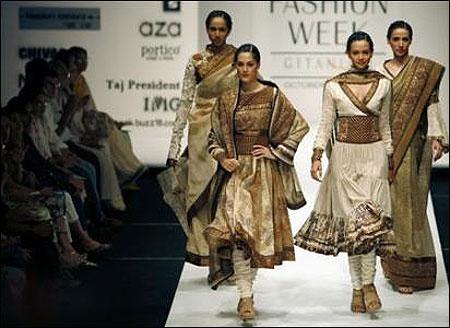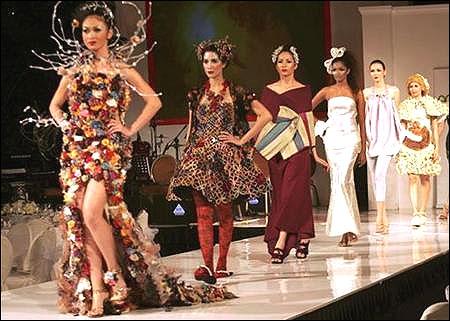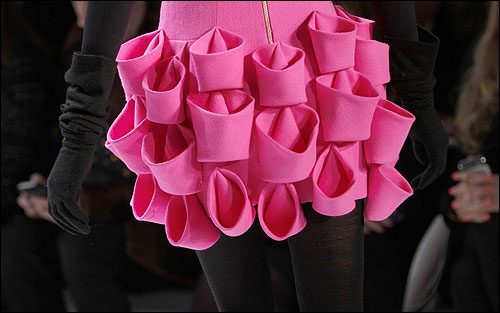 | « Back to article | Print this article |
Fashion industry: A story of consumption and waste
Professor Tonya Boone draws upon her research on sustainable supply chains to discuss the impact of fashion industry on the environment and the implications of fast fashion for India.
The fashion industry is one of the largest industrial sectors in the world. According to United Nations Environmental Program, the fashion sector - comprising textile and apparel creation and production, is the second largest global economic activity in terms of trade. The global sector is valued at $1.44 trillion.
The Indian industry generated $63 billion in 2010, accounting for 14 per cent of industrial production and 4.5 per cent of GDP. India, one of the largest producers of textiles and apparel, employs 35 million workers, second only to agriculture. I have recently started a project to explore the challenges and opportunities for sustainable, ethical fashion in India. The industry is so large that changes made here would have significant worldwide impact.
The fashion supply chain is diverse and complex, spanning four or more tiers, including design, raw material harvesting, spinning, yarn production, dyeing, weaving, cutting, stitching and final garment construction. It incorporates handcraft and cottage workers as well as high-volume technology intensive facilities.
Fashion supply chains and processes frequently cross international boundaries in pursuit of ideas and inspiration for design, and to access labour during garment construction. My research focuses on the design process - the adaptations made to accommodate ethical concerns and the effect on supply chain relationships.
You cannot achieve sustainable production without a sustainable design. Designers can have significant effect as their choices drive production in the near term, and fashion trends in the longer term. Designers' decisions about fabric, construction and production techniques constrain or facilitate the activities throughout the supply chain.
Click on NEXT for more...
Fashion industry: A story of consumption and waste
Fads that add
Fashion leaves a terrible environmental footprint along its entire supply chain. Textile and garment production facilities are large consumers of water and energy. The raw materials used in fibre production may be synthetic, such as rayon and nylon, animal-based, such as wool and silk, or plant-based, such as cotton and flax.
Each of these raw materials has a drawback. Synthetics are often petroleum-based, slow to decompose and difficult to recycle. Animal-based fibres use large quantities of water in washing and processing. Conventionally grown, plant-based fibres rely on petro-chemical pesticides, herbicides and fertilisers.
Artificial dyes may contain heavy metals, such as copper and chromium, which accumulate in ground water supplies, and are toxic to fish and humans. In addition, the various stages of textile and garment production process use solvents and hazardous chemicals that generate toxic waste water and volatile emissions.
The trail of damage to the environment continues even after the garments reach the end of the supply chain and onto the consumers' hands. Much of the environmental impact occurs during use due to frequent machine washing, drying and ironing.
Laundering consumes significant water, while machine drying consumes energy and emits greenhouse gases. Many of the surfactants used in detergents are toxic to aquatic life and persist in the environment for a long time. Many items also require dry cleaning, which uses petroleum-based solvents that have been linked to nervous system damage, and are possible carcinogens.
A BSR (Business for Social Responsibility) life cycle analysis concluded that laundering accounted for at least 40 per cent of apparel greenhouse gas emissions.
Click on NEXT for more...
Fashion industry: A story of consumption and waste
Fashion trends: Fast, furious and disastrous
Fast fashion, which references apparel with short product life cycles, has emerged as a potent competitive force. Fast fashion brands introduce new styles at more frequent intervals, focusing less on durable quality, and more on low costs and up to the minute designs.
One consequence of fast fashion has been an explosion in consumption accompanied by increased waste.
A 2006 University of Cambridge study found that UK consumers were buying one-third more clothing in 2006 than in 2002, with only a fraction being recycled.
According to the US EPA (Environment Protection Agency), more than 13 million tons of textiles were disposed of in the US in 2010. Only 15% was diverted from landfills or waste systems.
Click on NEXT for more...
Fashion industry: A story of consumption and waste
Flouting labour laws
The managerial malpractices in textile and apparel production have been cited in many reports. Researchers have concluded that labour laws were regularly violated in the fashion industry. A 2009 global survey by the International Trade Union Confederation found that apparel and textile manufacturing are among the worst violators of labour rights and fair trade practices.
Abuses identified by the researchers include killings, threats, forced overtime work, physical abuse, low wages, poor working conditions and lack of sick leaves. A 2009 study of working conditions in the US fashion industry by a coalition of labour researchers found the following abuses: unpaid overtime, denial of breaks, illegal pay deductions and retaliation for reporting illegal practices. Indian apparel and textile manufacturers have been blacklisted by the US department of labour because of child and forced labour.
The growth of mass production, and particularly fast fashion with its short product life cycles, has exacerbated environmental and social impacts. Over the last several years, India has witnessed a change in purchasing patterns, as consumers shift their apparel purchases from custom work by tailors to ready-to-wear. The ready-to-wear market is forecast to grow from Rs 1,543 billion in 2009 to Rs 4,000 billion in 2015.
Ready-to-wear offers more styling options, convenience, consistent quality and reduced time required to receive a finished garment. Mass production, however, displaces local artisans and crafts people. It moves self-employed workers, such as tailors to wage workers. The displacement of local artisans risks the loss of local techniques and skills.
The proposed FDI scheme by the Indian government could have a tremendous impact on this sector. It will likely accelerate penetration of retail into rural areas, and consequently, the growth of the ready-to-wear market. Proponents expect FDI will reduce prices for consumers. This is likely to put downward pressure on wages as garment construction is highly labour intensive.
Click on NEXT for more...
Fashion industry: A story of consumption and waste
Ethical Fashion: A step in the right direction
Sustainable or ethical fashion is a response to the environmental and social devastation wrought by conventional production techniques. It strives to provide a platform for ethnic communities and artisans, just treatment for workers and mitigation of harmful environmental effects. Ethical fashion captures some model examples of business social responsibility and environmental sustainability throughout the fashion supply chain.
My research has identified three primary approaches that designers use to incorporate sustainability. These approaches vary in the extent to which they address social and/or environmental issues. The first category of designers focus primarily on reducing negative environmental impacts.
They may try to lessen negative environmental impacts through material choices, by selecting next generation synthetics, recycled or organic raw materials in their designs in order to reduce resource consumption or the use of pesticides.
Alternatively, some have adopted fabric innovations based on bio-mimicry, nanotechnology or modularity to extend garment life or stretch time between washing. Other environmentally focused designers specify colours based on natural dyes which eliminate the toxic effects of dyeing. Also, in this category are designers who adopt construction or production techniques to mitigate negative environmental effects.
These designers typically insist on using sources that adhere to environmental standards, such as organic certification or, they may adopt construction techniques such as modularity or that allow consumers to customise the garment.
Next are designers who focus primarily on reducing the negative social and cultural impacts of fashion production. Designers in this category insist on fair trade and labour practices. In addition, they may choose textiles and construction techniques that rely on traditional weaving and handwork techniques that support local craftspeople and artisans.
For example, several Indian designers are showcasing modern garments that draw on India's varied and rich textile traditions, incorporating for example, hand block printing, and chanderi and khadi techniques and textiles.
Click on NEXT for more...
Fashion industry: A story of consumption and waste
Designers often use ethnic identities and native cultures as a source of inspiration and branding - frequently without giving credit or acknowledgment to the respective cultural traditions or artisans. In addition, conventional design processes tend to be relatively linear, with designers and their buyers sourcing raw materials and garments without much input from manufacturers.
Some ethical designers, on the other hand, integrate craftspeople and artisans into the design process, providing them with recognition and compensation for their craft. In effect, they become collaborators with the designer rather than labourers. This allows the designer to benefit from their knowledge about fibres, fabrics and techniques while providing timely market feedback to the artisans about their work.
Finally are designers who address environmental and social issues through their choices. This is the most challenging category. It requires vigilance and accountability throughout the supply chain. These designers may work with Global Organic Textile Standard (GOTS) certified facilities. GOTS indicates that a manufacturer's entire supply chain meets specified environmental and social criteria, and their performance has been independently verified.
By October 2011, India had more GOTS certified facilities than any other country. A number of companies have built brands around environmental and social performance. Patagonia, a US supplier of athletic apparel, is famous for its commitment to environmental sustainability. Alta Gracia, a Dominican Republic based supplier of collegiate apparel has built a loyal following on 450 US college campuses by committing to respecting worker rights and paying a living wage.
Bhu:sattva is a venture based in Ahmedabad, distinguishing itself through environmental and social responsibility, as well as cultural sensitivity. The number of designers who adhere to fair trade and environmentally responsible practices is growing slowly. Their work has been showcased during fashion week in London, New York, Paris and Milan.
Ethical fashion relies on conscious consumption by consumers. Designers are able to influence buyers' behaviour to some extent, but consumer engagement is important. Consumers' ethical fashion practices borrow heavily from practices around sustainable food. First, slow fashion attempts to manage the natural tension between fashion and consumption. Slow fashion is about buying fewer but longer lasting garments. It stresses thoughtfulness in apparel selection.
It emphasises durable, aesthetic and construction quality, and opposes standardisation and fashion fads.
Next, the local fashion movement emphasises the importance of place in fashion in order to strengthen the relationship between consumer and producer.
One goal of the movement is to make consumers more aware of the physiological as well as physical needs that fashion fulfils, and to consider the entire life cycle impacts of clothing – from raw material to disposal. Proponents of these consumer movements contend that getting consumers to buy clothes that reflect geographic place, better help to fulfil the psychological needs that fashion represents. Buying local also helps to sustain local materials and skills. Buying clothes close to their point of production helps to reduce the environmental impact of transporting clothing globally.
Ethical fashion requires collaboration between designers, manufacturers and consumers to adequately address the impact of production processes and consumption patterns. Ethical designers must meet consumers' needs in terms of style, comfort, quality, value and aesthetics while minimising environmental and social impacts. Consumers must consider how their buying habits and patterns of apparel use affect environments and cultures.
Professor Rishtee Batra of the ISB, and I are beginning a study in which we investigate the alignment between the aesthetic qualities desired by consumers and those provided by the designers. Sustainable and ethical fashion production poses a challenge to designers, producers and consumers. However, it also represents a source of creativity and innovation. Ethical fashion presents India with an enormous opportunity to capitalise on this movement in its nascent state.
Tonya Boone is Associate Professor of Operations Management at the Mason School of Business, College of William and Mary, and a Visiting Scholar at the ISB. The article was first published in ISB Insight - the quarterly magazine of the Indian School of Business





